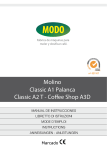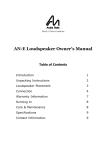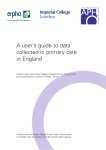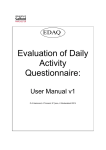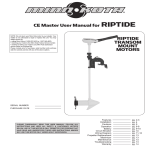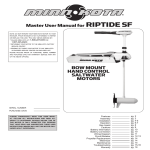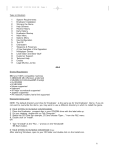Download OMB-M 003 OMB User Manual - A Guide to the OMB
Transcript
CONTROLLED DOCUMENT – ONLY EMBOSSED PAPER COPIES TO BE USED BEYOND DAY OF PRINTING Title: OMB Users Manual – A Guide to the OMB Serial Number: OMB-M003 Version Number: 4.10 (Draft) Version Approver: Enter name Version Approval Date: Enter a date Version Effective: On release Version Author: Gareth Bicknell Version Date: 04/09/2014 Area of Application: All OMB Areas Relevance: All OMB Users Date Details of Review Version number No. of pages 01/09/2008 New Document 1.0 17 31/08/2009 2.0 18 08/01/2010 3.0 13 11/02/2011 4.0 13 17/02/2012 5.0 8 09/01/2009 12/02/2010 18/02/2011 04/09/2014 Updated to reflect the changes to the OMB Structure Updated to reflect the changes to the OMB Structure Updated to reflect change in DI & PI. Addition of OMB logo. Reformatted. Sustantially rewritten to include just information of most direct use to end-users. Name of Reviewer Next Review Gareth Bicknell, Karolina Kliskey YOU ARE INSTRUCTED TO READ THE FOLLOWING THOROUGHLY BEFORE PROCEEDING TO UNDERTAKE THE METHODS DESCRIBED. UNDER NO CIRCUMSTANCES ARE THESE INSTRUCTIONS TO BE AMENDED OR ALTERED IN ANY WAY OTHER THAN BY THE AUTHOR / APPROVER. Approved Enter a date. OMB-M003 Version 4.10 (Draft) Printed 12/12/2014 Page 1 of 10 CONTROLLED DOCUMENT – ONLY EMBOSSED PAPER COPIES TO BE USED BEYOND DAY OF PRINTING Table Of Contents 1 PURPOSE .......................................................................................................... 3 2 DEFINITIONS ..................................................................................................... 3 2.1 2.2 2.3 2.4 2.5 HTA ....................................................................................................................... 3 REC....................................................................................................................... 3 PROTOCOL ............................................................................................................. 3 MHRA .................................................................................................................... 3 OMB TEAM ............................................................................................................. 3 3 PRINCIPLES....................................................................................................... 3 4 WHAT DOES THIS MEAN FOR YOU? .............................................................. 4 4.1 4.2 4.3 4.4 4.5 4.6 4.7 5 GENERALLY ............................................................................................................ 4 IF YOU INTEND TO TAKE CONSENT USING THE OMB CONSENT FORM ........................ 5 IF YOU INTEND TO COLLECT TISSUE OR DATA COVERED BY OMB CONSENT ............... 6 IF YOU INTEND TO STORE TISSUE IN OMB AREAS ..................................................... 7 IF YOU INTEND TO RELEASE OMB’S CUSTODY OF COLLECTED TISSUE OR DATA ......... 7 IF YOU INTEND TO USE TISSUE COVERED BY THE OMB MANAGEMENT PROTOCOL...... 7 IF YOU INTEND TO SHARE TISSUE COVERED BY THE OMB MANAGEMENT PROTOCOL.. 9 FUTHER INFORMATION ................................................................................. 10 Approved Enter a date. OMB-M003 Version 4.10 (Draft) Printed 12/12/2014 Page 2 of 10 CONTROLLED DOCUMENT – ONLY EMBOSSED PAPER COPIES TO BE USED BEYOND DAY OF PRINTING 1 Purpose 1.1 This manual aims to remind you of the most essential principles of using OMB, so that you understand why things are done in a particular way. 1.2 It can be read as a self-contained document by end-users, or as a supplement to the OMB Training Manual (OMB-M 004) by OMB Team members. 2 Definitions 2.1 HTA 2.1.1 Human Tissue Authority – the UK’s competent authority for regulating tissue in the type of research that you are likely to conduct. 2.2 REC 2.2.1 Research Ethics Committee – the UK mechanism for obtaining ethical permission to use tissue from humans. The only type of REC permitted to approve access to patients is an NHS REC. 2.3 Protocol 2.3.1 A formal document including a description of how consent, collection, storage, use, and disposal of tissue and data from humans is to be approached. 2.4 MHRA 2.4.1 Medicines and Healthcare Products Regulatory Authority – the UK’s competent authority for regulating medicines and medical devices. 2.5 OMB Team 2.5.1 Members of staff whose training is formally documented by OMB in order to comply with the conditions imposed by REC approval and HTA Licence. 3 Principles 3.1 Under the Declaration of Helsinki, and UK law enacting European directives, tissue collected from humans may usually only be used for research if covered by ethical approval. Approved Enter a date. OMB-M003 Version 4.10 (Draft) Printed 12/12/2014 Page 3 of 10 CONTROLLED DOCUMENT – ONLY EMBOSSED PAPER COPIES TO BE USED BEYOND DAY OF PRINTING 3.2 Ethical approval can be specific (the aims of the research and methods to be used, etc. are relatively well known in advance) – or it can be generic (where much less is certain). 3.3 Specific ethical approval, whilst it may be broad, allows a REC to assess risks to the patient fairly easily (safety, dignity, anonymity, etc.). Specific ethical approval (with or without extra regulatory approval as needed) is therefore usually sufficient to carry out the research in quesiton. 3.4 However, OMB’s generic ethical approval is, by definition, unable to give a REC enough information to assess risks in sufficient detail. It must therefore also obtain an HTA Licence to underpin its systems. 3.5 With both specific and generic approval, a Protocol is required to describe how the study is to be run – but the prescribed toolset though which compliance is assured for specific approvals is often just a matter of local policy (unless regulatory requirements become relevant). 3.6 To this extent, an HTA Licence requires a generic Protocol to maintain a Quality Management System documenting exactly how it intends to perform each and every activity. This includes consent, sample tracking, controlled release, constant monitoring of performance, and continuous quality improvement. 3.7 In many ways, the HTA Licence therefore parallels the conduct of a clinical trial under MHRA approval. All documentation and records must be tightly controlled, signed, dated, and retained centrally for 5-30 years after last use. As with many regulators, HTA inspectors are taught how to spot non-compliant and fraudulent activity. 4 What Does This Mean for You? 4.1 Generally 4.1.1 In essence, there is little difference between the data that you should be keeping under specific REC approval and that which you must be keeping under licensed generic approval. Approved Enter a date. OMB-M003 Version 4.10 (Draft) Printed 12/12/2014 Page 4 of 10 CONTROLLED DOCUMENT – ONLY EMBOSSED PAPER COPIES TO BE USED BEYOND DAY OF PRINTING 4.1.2 OMB strives to minimise the negative impact of such data collection on your time. Nonetheless, when we ask you to provide data, or to perform activities in a certain way, the HTA and/or the REC expects you to comply. NB – we welcome requests for an explanation, or a suggestion of alternatives, but you must comply in the meantime. As the saying goes, “You don’t have to like it, but you do have to do it.” 4.2 If You Intend to Take Consent Using the OMB Consent Form 4.2.1 You must maintain current records of your training in the OMB Office, and we must have formally approved you as a consenter, before you begin. Why? REC approval requires you to take consent as described in the Protocol, and for your role to be documented in a “delegation log”. The HTA Licence requires consent to be taken and verified according to SOPs, and for training records to be maintained centrally. The HTA expects training records to be audited internally on a regular basis to prevent slip-ups that specific studies might only pick up at the end. 4.2.2 You must complete an ethics comprehension test if we ask you to. Why? REC approval expects you to be able to give the patient an explanation of anything covered by the Protocol, not just the patient information sheet. We accept that the Protocol is (necessarily) a long and rather dry document, so we want to be sure you will give correct answers to any patient questions. Many patients trust us implicitly, and do not ask questions – but those that do deserve accurate answers. 4.2.3 You must have at least an honorary contract with the Trust, which requires that you take certain mandatory elements of Trust training. Why? The Trust must ensure that staff interacting with patients are indemnified against complaints and litigation. The Trust must demonstrate that staff are sufficiently trained in basic Health & Safety, as well as other regulatory aspects of working life in a hospital. Approved Enter a date. OMB-M003 Version 4.10 (Draft) Printed 12/12/2014 Page 5 of 10 CONTROLLED DOCUMENT – ONLY EMBOSSED PAPER COPIES TO BE USED BEYOND DAY OF PRINTING 4.3 If You Intend to Collect Tissue or Data Covered by OMB Consent 4.3.1 You must maintain current records of your training in the OMB Office, and we must have formally approved you as a collector, before you begin. Why? REC approval requires you to collect samples only as described in the Protocol, and for your role to be documented in a “delegation log”. The HTA Licence requires consent to be deemed satisfactory before acceptance of tissue under the licence, and for training records to be maintained centrally. The HTA expects training and procedural records to be audited internally on a regular basis to prevent slip-ups that specific studies might only pick up at the end. 4.3.2 You must ensure that tissue and data for your project(s) has been approved in a recorded fashion by the OMB before you acquire it – otherwise, it can only be stored by OMB itself. Why? REC approval requires researchers to collect only the tissue and data that OMB has asked for. REC approval requires OMB to apply the same rules of approval to individual researchers. The HTA Licence requires documented control of access to tissue. NB – by analogy, you would not ask a REC to approve taking blood, and then take bone as well. You would not ask a REC to approve 20 ml of blood, and then take 50 ml. As a REC surrogate, OMB must be aware of everything you want before you acquire it. We are approved to collect pretty much anything – but you are not until we have documented it! 4.3.3 You must only obtain tissue via named clinical staff that OMB has pre-approved. Why? The generic nature of the Protocol means that the REC cannot approve named staff in advance – it delgates this duty to OMB. Approved Enter a date. OMB-M003 Version 4.10 (Draft) Printed 12/12/2014 Page 6 of 10 CONTROLLED DOCUMENT – ONLY EMBOSSED PAPER COPIES TO BE USED BEYOND DAY OF PRINTING Courtesy – OMB must ensure clinicians have been properly consulted, and that they are genuinely in favour of helping. 4.4 If You Intend to Store Tissue in OMB Areas 4.4.1 You must only attempt to transfer samples into, or out of, OMB’s designated storage areas once explicitly permitted by OMB Management. Why? The HTA Licence requires physical access to tissue to be strictly controlled to avoid accidental release, loss, damage, breaks in traceability, etc.. After consent, physical access is the most critical facet of the licence. 4.5 If You Intend to Release OMB’s Custody of Collected Tissue or Data 4.5.1 You must maintain current records of your training in the OMB Office, and we must have formally approved you as a releaser, before you begin. Why? REC approval requires released data to be at least pseudo-anonymised. The HTA Licence requires released tissue to be at least pseudoanonymised, and for training records to be maintained centrally. The HTA expects training and procedural records to be audited internally on a regular basis to prevent slip-ups that specific studies might only pick up at the end. 4.5.2 You must only release tissue that your project(s) have been approved to use. Why? REC approval requires researchers to use only the tissue that OMB has permission to collect and distribute. REC approval requires OMB to apply the same rules of approval to individual researchers as a REC would (e.g. scientific merit). 4.6 The HTA Licence requires documented control of access to tissue. If You Intend to Use Tissue Covered by the OMB Management Protocol 4.6.1 You must only use tissue if you have signed a Declaration. Why? Approved Enter a date. OMB-M003 Version 4.10 (Draft) Printed 12/12/2014 Page 7 of 10 CONTROLLED DOCUMENT – ONLY EMBOSSED PAPER COPIES TO BE USED BEYOND DAY OF PRINTING REC approval requires you to honour the promises we made to patients during consent (such as not using samples in animals, or paternity testing, or deliberate diagnostics, or reproductive research, or abortion research, etc.). 4.6.2 You must only use the tissue your project(s) have been approved to use, and only with the techniques described. Why? REC approval requires researchers to use tissue only in the general ways described in OMB’s Protocol. REC approval requires OMB to apply the same rules of approval to individual researchers as a REC would (e.g. scientific merit). The HTA Licence requires OMB to ensure that tissue, or tissue products, are not put back into humans, or used to create embryos. NB – by analogy, you would not ask a REC to approve blood smears, and then perform bone histology as well. You would not ask a REC to approve bone cancer genetics, and then perform paternity testing. As a REC surrogate, OMB must be aware of what you want to do before you take tissue away. We have been approved to allow a large range of techniques – but you have not until we have documented it! 4.6.3 You must be able to tell us the final fate of every sample if asked. Why? In most cases of relevance to you, the Human Tissue Act requires storage of “original” cellular material to be covered by active REC approval or an HTA Licence The HTA Licence requires full traceability of samples from consent to the moment they cease to contain whole original cells (while under Licence) REC approval necessitates the ability to show that tissue has been used within the terms of the Protocol (when not under Licence) Public funders demand that tissue not be “hoarded” 4.6.4 You must acknowledge the NIHR, OMB and collaborators in your publications. Why? Approved Enter a date. OMB-M003 Version 4.10 (Draft) Printed 12/12/2014 Page 8 of 10 CONTROLLED DOCUMENT – ONLY EMBOSSED PAPER COPIES TO BE USED BEYOND DAY OF PRINTING Apart from courtesy, REC approval and public funders are beginning to demand such acknowledgement Movement has already begun towards reviewing only manuscripts where tissue sources are clearly defined (on the grounds of quality) 4.7 If You Intend to Share Tissue Covered by the OMB Management Protocol 4.7.1 It is permissible for projects to share samples amongst themselves, providing: Both the acquisition and end-use projects share similar enough aims and selection criteria to be scientifically appropriate The acquisition project is already approved to acquire the tissue in the format desired The end-use project is already approved to use tissue in the manner desired The acquisition records quote the acquisition project reference The release records quote the end-use project reference All staff “crossing over” into the acquisition project have been communicated to OMB, and have already been signed off by OMB Management on any relevant training All researchers “crossing over” into the end-use project have been communicated to OMB Management, and have already presented a signed Declaration to OMB Management 4.7.2 Such collaborations are consistent with the policy to allow pre-defined “collection” and “end-use” sub-protocols and projects within, or amongst, single research groups – but you must not share tissue with someone who has not been put “on OMB’s books”. Why? The HTA Licence requires full traceability of samples from consent to the moment they cease to contain whole original cells (while under Licence) REC approval necessitates the ability to show that tissue has been used within the terms of the Protocol (when not under Licence) Approved Enter a date. OMB-M003 Version 4.10 (Draft) Printed 12/12/2014 Page 9 of 10 CONTROLLED DOCUMENT – ONLY EMBOSSED PAPER COPIES TO BE USED BEYOND DAY OF PRINTING 5 Futher Information 5.1.1 If you would like to explore further, you may view the OMB Management Protocol (NDORMS-PROT 01) and the OMB Quality Manual (OMB-M 001) online at http://omb.ndorms.ox.ac.uk in the Public Documents section. These detail OMB’s ethical and licence requirements resepectively. Approved Enter a date. OMB-M003 Version 4.10 (Draft) Printed 12/12/2014 Page 10 of 10










